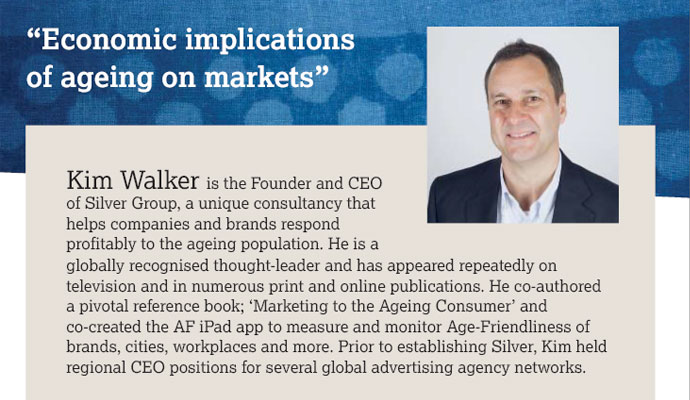
Please give examples of businesses and markets that are emerging due to ageing society in Asia. How big is the ageing market?
During the next two decades, older consumers will be the primary drivers of consumer expenditure in Asia Pacific, Europe and the US. Compared to younger cohorts, many older people have accumulated more wealth. For example, in Asia Pacific today, fifty-four percent of high net worth individuals are over 56 years of age.
By some estimates the ageing market in Asia Pacific will reach US$3.3 trillion by 2020. However, we believe this figure is a gross underestimation of the potential power of the ageing consumer. The reason for the underestimation is that it is focused on what we call ‘age-silo’ products and services; those which are designed specifically for use by older people. This includes industries such as healthcare, housing, pharmaceuticals, medical equipment, automation, and assistive devices. While the ‘age-silo’ segment is important and poised for dramatic growth, it does not reflect the total purchasing power of the older consumer.
Regardless of age, people need to eat, dress and maintain their health and beauty. They want to travel, to learn and to be entertained. We refer to this market as ‘age-neutral’ or, in cases where there has been some adaptation for older consumers; we call it ‘ageadapted’.
Adding these segments to the more traditional ‘age-silo’ view presents a more accurate, explosive and exciting outlook for the ageing market.
Can you explain the ‘age-friendly’ concept? And why do you think it is important that the market adopts this approach?
With increased longevity, the attitudes and desires between generations are converging. However, the physical, sensory and cognitive decline that accompanies the natural process of ageing will increasingly impact our ability to engage with our environments.
In the vast majority of cases, products and services, the cities we live in and the places where we work have been designed for the young, by the young. This functioned well when the designers and users were the same age as in generations past. However, the gap between the age of the designers and the users is now growing rapidly.
Being age-friendly demands that we redesign the customer experience to be inclusive of the needs of older people, specifically their physiological differences. We need to understand these differences and accommodate them naturally into the customer experience. In this way the consumer does not feel stigmatised by their age when using a product or service. Furthermore, and of critical concern to many businesses, if done properly this will not adversely impact or deter younger customers.
Companies that incorporate age-friendly thinking into their culture can use this global force as a competitive weapon. Market pressures will compel others to follow, but they will appear reactive and defensive, and the delay will probably cost them more money.
The private sector seems to be leading in the silver market today, so how can governments and civil society keep up the pace and ensure that all sectors are working in collaboration and for their mutual benefit?
The private sector may be leading in the age-silo market as defined above, but we are not convinced that the private sector has shown much commitment to the inclusiveness of older consumers. We have witnessed many companies that display a surge of interest in the silver market, only to see that interest wane as quickly as it arrived.
It would be easy to suggest that government leadership is required in this area to spur the private sector into action, but the Singapore example throws doubt on this notion. Despite concerted, multi-pronged initiatives by that government over the past decade to address the impact of an ageing society, Singapore’s private sector has responded sluggishly and uncreatively.
Business reacts to the stimulus of ‘pain’ or ‘gain’. The trigger to act will come from clear signals that their business is suffering due to inattention to the ageing consumer, or evidence of growth attributable to the sector.
There is a common flaw to many of the governmental and commercial attempts to address the silver market; that is their myopic, departmental focus. Whether a city or a brand, ageing solutions must be viewed through a holistic, interdepartmental lens. In a brand sense, executives need to review the entire customer experience to identify and remove potential barriers at every point of that experience.
How can older people get involved and profit from this market share, apart from being customers?
Apart from the naivety of ignoring the huge potential of older customers, companies that fail to adapt their customer experiences to accommodate the needs of older consumers are, in effect, excluding them. That’s ageism! The issue was amplified in a recent marketing magazine article about diversity and inclusiveness. The article quoted industry luminaries and cited market cases around the subjects of racial inclusion, LGBT inclusion, gender inclusion and cultural inclusion, yet there was no mention of age inclusion! This oversight is indicative of the frustrating lack of attention being given to ageism.
Perhaps the best way for older people to become involved is to raise their voices against ageism in all its forms. We need to start challenging companies who make their customer experience inaccessible to older adults; this includes packages that are difficult to open, instructions that are hard to read or to comprehend, advertising images that are inappropriate or exclusive of older people, websites and apps that are difficult to navigate, retail environments that are unwelcoming for older shoppers and so on.
In order to do this, we need to become more self-aware and proud of our age. We need to understand how our needs are changing with age and we must be more outspoken when we find any touchpoints (where the consumer engages with a company) that are no longer easily accessible or are clearly designed to exclude.

